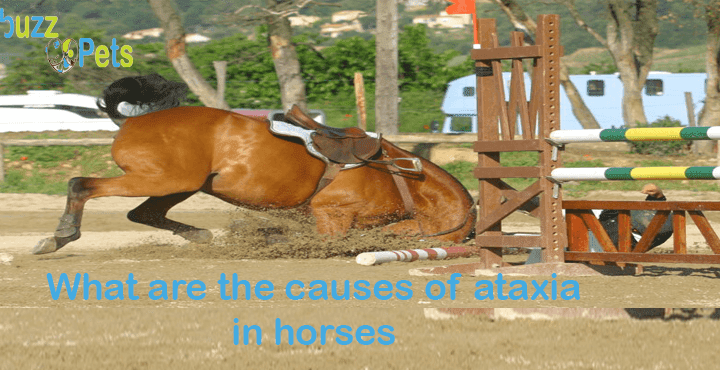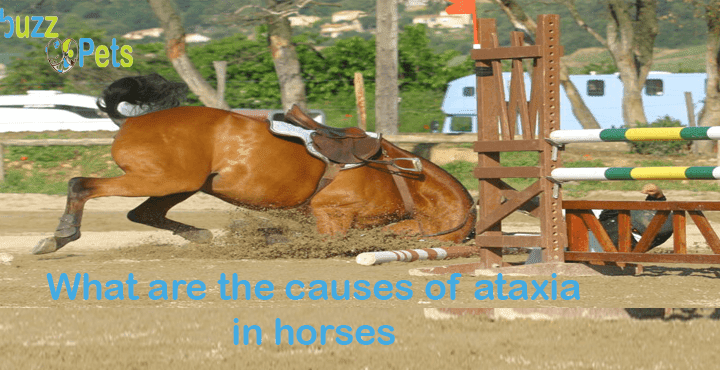There are many causes of ataxia in horses.
The most frequently cited is Wobbler’s syndrome, linked to a malformation of the neck, but it is far from the only one.
The most frequently cited is Wobbler’s syndrome, linked to a malformation of the neck, but it is far from the only one.
1. Mechanical causes
They are linked to compression of the spinal cord in the cervical region of the horse.
In fact, ataxia is a symptom of neurological damage generally localized in the cervical region.
The nerve signal does not pass well between the brain, which sends the command, and the limbs, which perform the movement. This incoordination results from it.
Thus, it can range from a transient compression, with symptoms that appear only at the level of the neckline, in certain positions (usually head up), and which disappear when the neckline is low; intense, very painful compression associated with paralysis of the limbs. All intermediate stages are possible.
They are linked to compression of the spinal cord in the cervical region of the horse.
In fact, ataxia is a symptom of neurological damage generally localized in the cervical region.
The nerve signal does not pass well between the brain, which sends the command, and the limbs, which perform the movement. This incoordination results from it.
Thus, it can range from a transient compression, with symptoms that appear only at the level of the neckline, in certain positions (usually head up), and which disappear when the neckline is low; intense, very painful compression associated with paralysis of the limbs. All intermediate stages are possible.
Among the mechanical causes we find:
Wobbler’s syndrome
It is an instability of the cervical vertebrae, usually related to a malformation. This instability causes a reduction in the diameter of the vertebral canal and therefore compression of the spinal cord.
They are usually exacerbated when the horse’s head is raised. Depending on the severity of the condition, the ataxia may worsen with growth or stabilize. In the absence of treatment, the sporting prognosis is poor, and the vital prognosis depends on the severity of the symptoms. The diagnosis is confirmed on an x-ray, by measuring the spinal canal, which can be quite tricky.
Cervical fractures
Symptoms will usually be sudden onset and following trauma, which guides the diagnosis.
However, in the event of a horse found lying down, this is not necessarily obvious. X-rays of the neck will confirm a suspected fracture.
Cervical osteoarthritis
The symptoms will be similar to those of Wobbler’s syndrome but will generally affect older horses. Contrary to what one might think, they can be sudden onset, due to a wrong move or unusual exertion.
Severe inflammation in the neck area
Following a trauma to the neck, you may have a hematoma near the neck, causing signs of ataxia. It can also happen as a result of a bad reaction to an intramuscular injection, causing inflammation or abscess of the neck.
2. Biological causes
Here we find viruses attacking the nervous system.
The disease usually starts with a mild form of ataxia that worsens, associated with a spike in fever that may go unnoticed. Within 48 to 72 hours, the horse is usually lying down and unable to get up.
The second virus present in France and causing this type of symptoms is that of West-Nile.
Transmitted by mosquito bites, this virus is mainly present in the south, especially in the Camargue.
The first signs: weakness and peak fever, usually go unnoticed, but a few days later, neurological signs may appear. It can be ataxia, but it can also be tremors or behavioral disturbances. The course may be favorable in 3 to 4 weeks or the horse may degrade to paralysis, coma and death.
Following a trauma to the neck, you may have a hematoma near the neck, causing signs of ataxia. It can also happen as a result of a bad reaction to an intramuscular injection, causing inflammation or abscess of the neck.
2. Biological causes
Here we find viruses attacking the nervous system.
The disease usually starts with a mild form of ataxia that worsens, associated with a spike in fever that may go unnoticed. Within 48 to 72 hours, the horse is usually lying down and unable to get up.
The second virus present in France and causing this type of symptoms is that of West-Nile.
Transmitted by mosquito bites, this virus is mainly present in the south, especially in the Camargue.
The first signs: weakness and peak fever, usually go unnoticed, but a few days later, neurological signs may appear. It can be ataxia, but it can also be tremors or behavioral disturbances. The course may be favorable in 3 to 4 weeks or the horse may degrade to paralysis, coma and death.
bacterial or protozoan infections
Bacterial neurological damage more often affects the brain (meningitis) than the spinal cord, so ataxia is rarely the main sign. On the other hand, there is protozoan encephalomyelitis (assimilated to a parasite but very similar to a bacterium), in the United States, which causes ataxia.
Horse poisoning
Many poisonings can cause neurological symptoms, including ataxia, however, they are generally associated with other symptoms (colic, diarrhea, etc.).
Among the most frequent causes, we find poisoning with Robinia False Acacia, Seneçon, and sometimes certain pesticides or insecticides.
Bacterial neurological damage more often affects the brain (meningitis) than the spinal cord, so ataxia is rarely the main sign. On the other hand, there is protozoan encephalomyelitis (assimilated to a parasite but very similar to a bacterium), in the United States, which causes ataxia.
Horse poisoning
Many poisonings can cause neurological symptoms, including ataxia, however, they are generally associated with other symptoms (colic, diarrhea, etc.).
Among the most frequent causes, we find poisoning with Robinia False Acacia, Seneçon, and sometimes certain pesticides or insecticides.


